BMP4005: Big Data Analysis and Information Systems Report
VerifiedAdded on 2023/06/12
|6
|1802
|206
Report
AI Summary
This report provides an overview of big data, defining its characteristics such as variety, velocity, volume, and value. It explores the challenges associated with big data analytics, including a lack of skilled professionals, data integration from diverse sources, security concerns, data growth issues, and the difficulty in selecting appropriate tools. The report also discusses various techniques for analyzing big data, such as A/B testing, data fusion and integration, statistics, data mining, and natural language processing. Furthermore, it explains how big data technology can support business by improving product quality, ensuring data safety and security, facilitating better decision-making, optimizing resource utilization, and tapping into potential customer bases. The analysis is supported by examples and references to relevant academic sources.
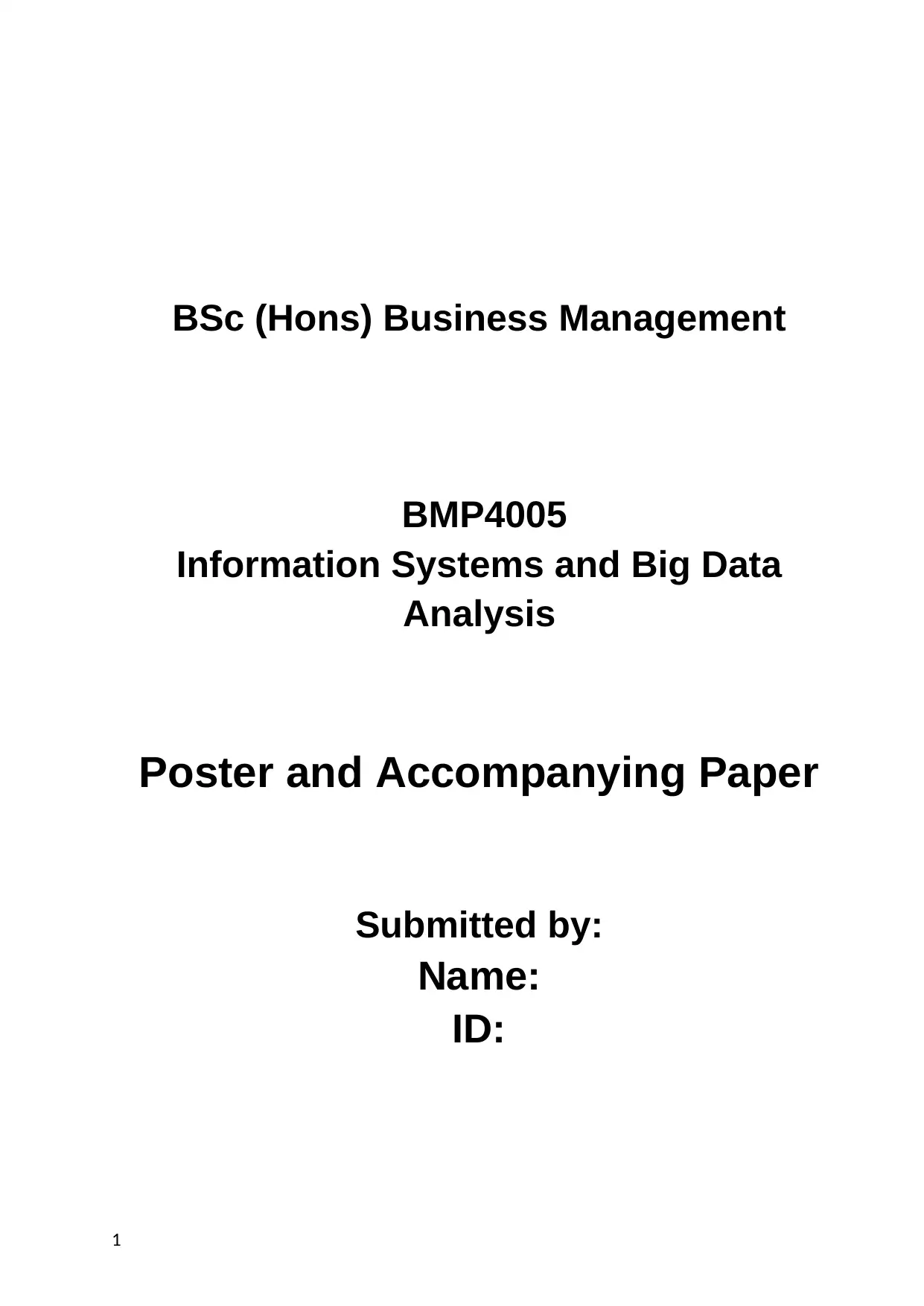
BSc (Hons) Business Management
BMP4005
Information Systems and Big Data
Analysis
Poster and Accompanying Paper
Submitted by:
Name:
ID:
1
BMP4005
Information Systems and Big Data
Analysis
Poster and Accompanying Paper
Submitted by:
Name:
ID:
1
Paraphrase This Document
Need a fresh take? Get an instant paraphrase of this document with our AI Paraphraser
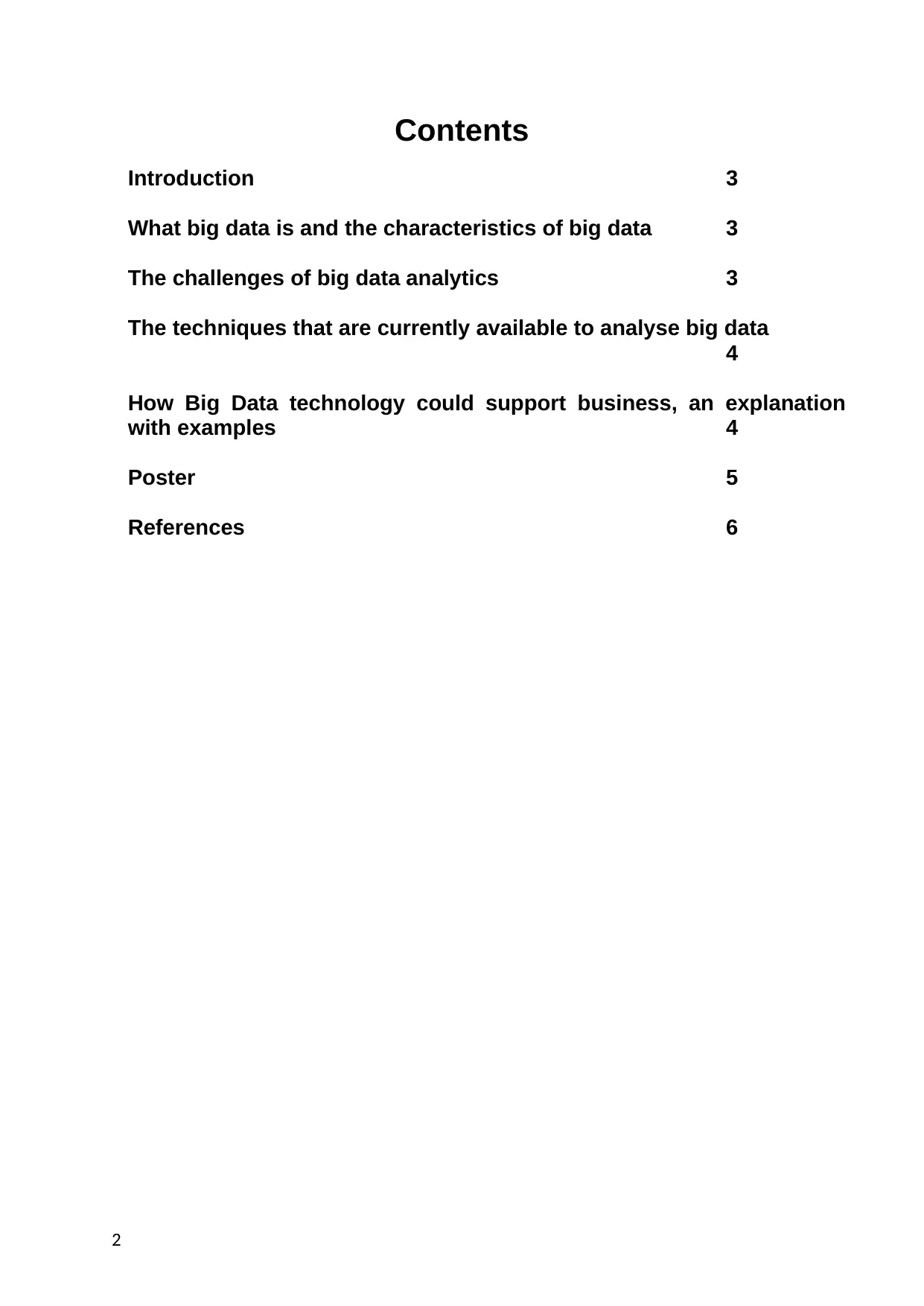
Contents
Introduction 3
What big data is and the characteristics of big data 3
The challenges of big data analytics 3
The techniques that are currently available to analyse big data
4
How Big Data technology could support business, an explanation
with examples 4
Poster 5
References 6
2
Introduction 3
What big data is and the characteristics of big data 3
The challenges of big data analytics 3
The techniques that are currently available to analyse big data
4
How Big Data technology could support business, an explanation
with examples 4
Poster 5
References 6
2
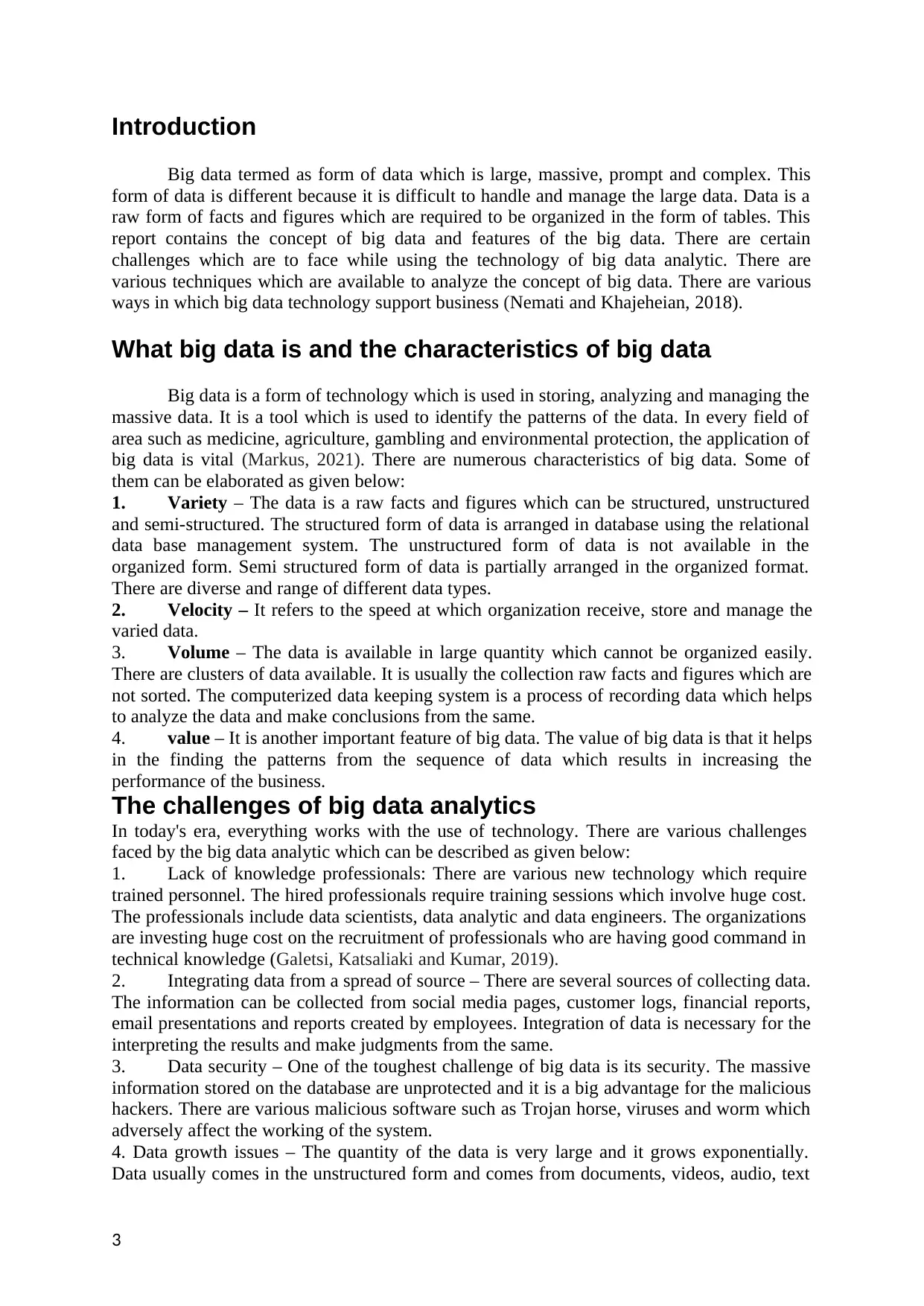
Introduction
Big data termed as form of data which is large, massive, prompt and complex. This
form of data is different because it is difficult to handle and manage the large data. Data is a
raw form of facts and figures which are required to be organized in the form of tables. This
report contains the concept of big data and features of the big data. There are certain
challenges which are to face while using the technology of big data analytic. There are
various techniques which are available to analyze the concept of big data. There are various
ways in which big data technology support business (Nemati and Khajeheian, 2018).
What big data is and the characteristics of big data
Big data is a form of technology which is used in storing, analyzing and managing the
massive data. It is a tool which is used to identify the patterns of the data. In every field of
area such as medicine, agriculture, gambling and environmental protection, the application of
big data is vital (Markus, 2021). There are numerous characteristics of big data. Some of
them can be elaborated as given below:
1. Variety – The data is a raw facts and figures which can be structured, unstructured
and semi-structured. The structured form of data is arranged in database using the relational
data base management system. The unstructured form of data is not available in the
organized form. Semi structured form of data is partially arranged in the organized format.
There are diverse and range of different data types.
2. Velocity – It refers to the speed at which organization receive, store and manage the
varied data.
3. Volume – The data is available in large quantity which cannot be organized easily.
There are clusters of data available. It is usually the collection raw facts and figures which are
not sorted. The computerized data keeping system is a process of recording data which helps
to analyze the data and make conclusions from the same.
4. value – It is another important feature of big data. The value of big data is that it helps
in the finding the patterns from the sequence of data which results in increasing the
performance of the business.
The challenges of big data analytics
In today's era, everything works with the use of technology. There are various challenges
faced by the big data analytic which can be described as given below:
1. Lack of knowledge professionals: There are various new technology which require
trained personnel. The hired professionals require training sessions which involve huge cost.
The professionals include data scientists, data analytic and data engineers. The organizations
are investing huge cost on the recruitment of professionals who are having good command in
technical knowledge (Galetsi, Katsaliaki and Kumar, 2019).
2. Integrating data from a spread of source – There are several sources of collecting data.
The information can be collected from social media pages, customer logs, financial reports,
email presentations and reports created by employees. Integration of data is necessary for the
interpreting the results and make judgments from the same.
3. Data security – One of the toughest challenge of big data is its security. The massive
information stored on the database are unprotected and it is a big advantage for the malicious
hackers. There are various malicious software such as Trojan horse, viruses and worm which
adversely affect the working of the system.
4. Data growth issues – The quantity of the data is very large and it grows exponentially.
Data usually comes in the unstructured form and comes from documents, videos, audio, text
3
Big data termed as form of data which is large, massive, prompt and complex. This
form of data is different because it is difficult to handle and manage the large data. Data is a
raw form of facts and figures which are required to be organized in the form of tables. This
report contains the concept of big data and features of the big data. There are certain
challenges which are to face while using the technology of big data analytic. There are
various techniques which are available to analyze the concept of big data. There are various
ways in which big data technology support business (Nemati and Khajeheian, 2018).
What big data is and the characteristics of big data
Big data is a form of technology which is used in storing, analyzing and managing the
massive data. It is a tool which is used to identify the patterns of the data. In every field of
area such as medicine, agriculture, gambling and environmental protection, the application of
big data is vital (Markus, 2021). There are numerous characteristics of big data. Some of
them can be elaborated as given below:
1. Variety – The data is a raw facts and figures which can be structured, unstructured
and semi-structured. The structured form of data is arranged in database using the relational
data base management system. The unstructured form of data is not available in the
organized form. Semi structured form of data is partially arranged in the organized format.
There are diverse and range of different data types.
2. Velocity – It refers to the speed at which organization receive, store and manage the
varied data.
3. Volume – The data is available in large quantity which cannot be organized easily.
There are clusters of data available. It is usually the collection raw facts and figures which are
not sorted. The computerized data keeping system is a process of recording data which helps
to analyze the data and make conclusions from the same.
4. value – It is another important feature of big data. The value of big data is that it helps
in the finding the patterns from the sequence of data which results in increasing the
performance of the business.
The challenges of big data analytics
In today's era, everything works with the use of technology. There are various challenges
faced by the big data analytic which can be described as given below:
1. Lack of knowledge professionals: There are various new technology which require
trained personnel. The hired professionals require training sessions which involve huge cost.
The professionals include data scientists, data analytic and data engineers. The organizations
are investing huge cost on the recruitment of professionals who are having good command in
technical knowledge (Galetsi, Katsaliaki and Kumar, 2019).
2. Integrating data from a spread of source – There are several sources of collecting data.
The information can be collected from social media pages, customer logs, financial reports,
email presentations and reports created by employees. Integration of data is necessary for the
interpreting the results and make judgments from the same.
3. Data security – One of the toughest challenge of big data is its security. The massive
information stored on the database are unprotected and it is a big advantage for the malicious
hackers. There are various malicious software such as Trojan horse, viruses and worm which
adversely affect the working of the system.
4. Data growth issues – The quantity of the data is very large and it grows exponentially.
Data usually comes in the unstructured form and comes from documents, videos, audio, text
3
⊘ This is a preview!⊘
Do you want full access?
Subscribe today to unlock all pages.

Trusted by 1+ million students worldwide
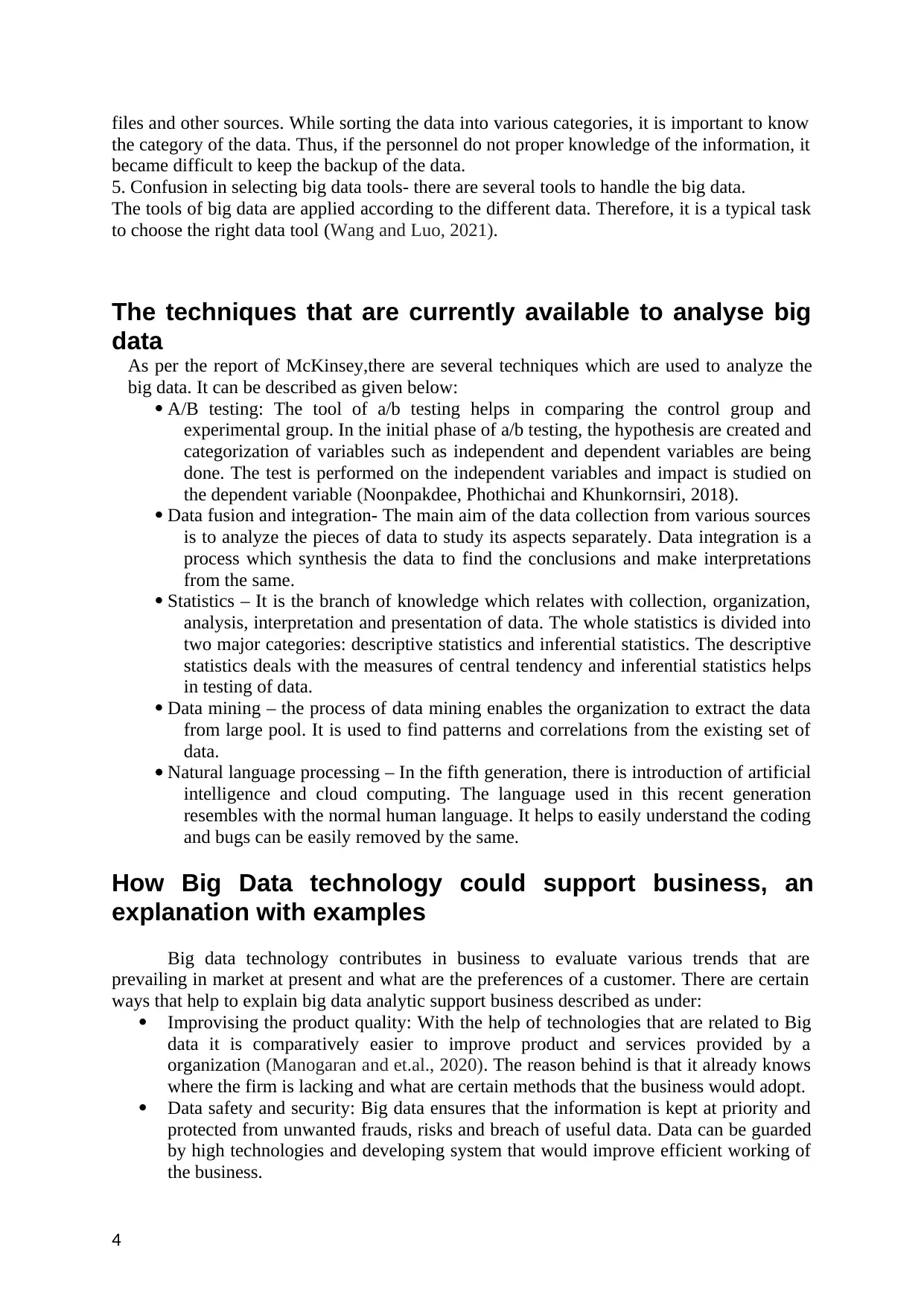
files and other sources. While sorting the data into various categories, it is important to know
the category of the data. Thus, if the personnel do not proper knowledge of the information, it
became difficult to keep the backup of the data.
5. Confusion in selecting big data tools- there are several tools to handle the big data.
The tools of big data are applied according to the different data. Therefore, it is a typical task
to choose the right data tool (Wang and Luo, 2021).
The techniques that are currently available to analyse big
data
As per the report of McKinsey,there are several techniques which are used to analyze the
big data. It can be described as given below:
A/B testing: The tool of a/b testing helps in comparing the control group and
experimental group. In the initial phase of a/b testing, the hypothesis are created and
categorization of variables such as independent and dependent variables are being
done. The test is performed on the independent variables and impact is studied on
the dependent variable (Noonpakdee, Phothichai and Khunkornsiri, 2018).
Data fusion and integration- The main aim of the data collection from various sources
is to analyze the pieces of data to study its aspects separately. Data integration is a
process which synthesis the data to find the conclusions and make interpretations
from the same.
Statistics – It is the branch of knowledge which relates with collection, organization,
analysis, interpretation and presentation of data. The whole statistics is divided into
two major categories: descriptive statistics and inferential statistics. The descriptive
statistics deals with the measures of central tendency and inferential statistics helps
in testing of data.
Data mining – the process of data mining enables the organization to extract the data
from large pool. It is used to find patterns and correlations from the existing set of
data.
Natural language processing – In the fifth generation, there is introduction of artificial
intelligence and cloud computing. The language used in this recent generation
resembles with the normal human language. It helps to easily understand the coding
and bugs can be easily removed by the same.
How Big Data technology could support business, an
explanation with examples
Big data technology contributes in business to evaluate various trends that are
prevailing in market at present and what are the preferences of a customer. There are certain
ways that help to explain big data analytic support business described as under:
Improvising the product quality: With the help of technologies that are related to Big
data it is comparatively easier to improve product and services provided by a
organization (Manogaran and et.al., 2020). The reason behind is that it already knows
where the firm is lacking and what are certain methods that the business would adopt.
Data safety and security: Big data ensures that the information is kept at priority and
protected from unwanted frauds, risks and breach of useful data. Data can be guarded
by high technologies and developing system that would improve efficient working of
the business.
4
the category of the data. Thus, if the personnel do not proper knowledge of the information, it
became difficult to keep the backup of the data.
5. Confusion in selecting big data tools- there are several tools to handle the big data.
The tools of big data are applied according to the different data. Therefore, it is a typical task
to choose the right data tool (Wang and Luo, 2021).
The techniques that are currently available to analyse big
data
As per the report of McKinsey,there are several techniques which are used to analyze the
big data. It can be described as given below:
A/B testing: The tool of a/b testing helps in comparing the control group and
experimental group. In the initial phase of a/b testing, the hypothesis are created and
categorization of variables such as independent and dependent variables are being
done. The test is performed on the independent variables and impact is studied on
the dependent variable (Noonpakdee, Phothichai and Khunkornsiri, 2018).
Data fusion and integration- The main aim of the data collection from various sources
is to analyze the pieces of data to study its aspects separately. Data integration is a
process which synthesis the data to find the conclusions and make interpretations
from the same.
Statistics – It is the branch of knowledge which relates with collection, organization,
analysis, interpretation and presentation of data. The whole statistics is divided into
two major categories: descriptive statistics and inferential statistics. The descriptive
statistics deals with the measures of central tendency and inferential statistics helps
in testing of data.
Data mining – the process of data mining enables the organization to extract the data
from large pool. It is used to find patterns and correlations from the existing set of
data.
Natural language processing – In the fifth generation, there is introduction of artificial
intelligence and cloud computing. The language used in this recent generation
resembles with the normal human language. It helps to easily understand the coding
and bugs can be easily removed by the same.
How Big Data technology could support business, an
explanation with examples
Big data technology contributes in business to evaluate various trends that are
prevailing in market at present and what are the preferences of a customer. There are certain
ways that help to explain big data analytic support business described as under:
Improvising the product quality: With the help of technologies that are related to Big
data it is comparatively easier to improve product and services provided by a
organization (Manogaran and et.al., 2020). The reason behind is that it already knows
where the firm is lacking and what are certain methods that the business would adopt.
Data safety and security: Big data ensures that the information is kept at priority and
protected from unwanted frauds, risks and breach of useful data. Data can be guarded
by high technologies and developing system that would improve efficient working of
the business.
4
Paraphrase This Document
Need a fresh take? Get an instant paraphrase of this document with our AI Paraphraser
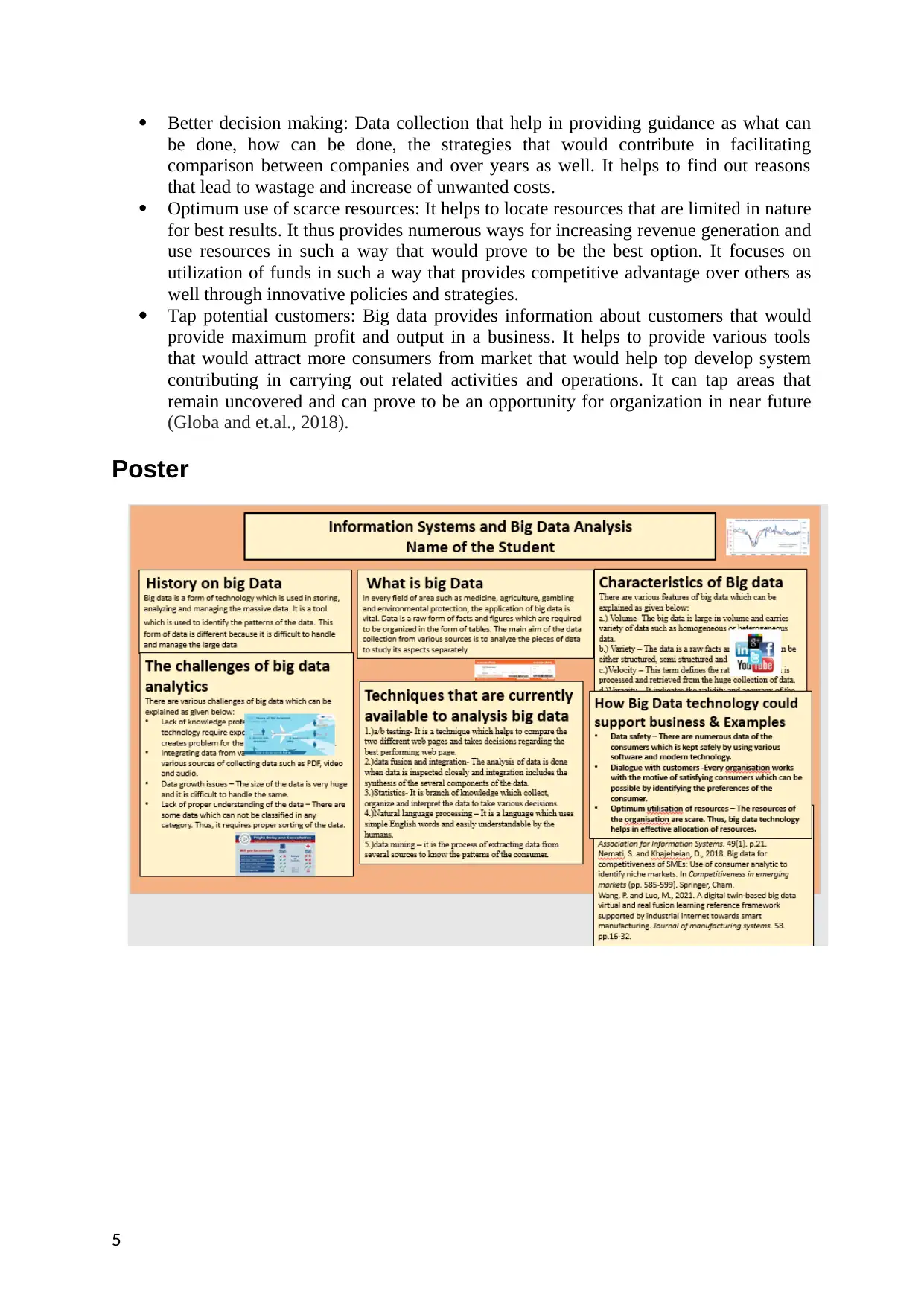
Better decision making: Data collection that help in providing guidance as what can
be done, how can be done, the strategies that would contribute in facilitating
comparison between companies and over years as well. It helps to find out reasons
that lead to wastage and increase of unwanted costs.
Optimum use of scarce resources: It helps to locate resources that are limited in nature
for best results. It thus provides numerous ways for increasing revenue generation and
use resources in such a way that would prove to be the best option. It focuses on
utilization of funds in such a way that provides competitive advantage over others as
well through innovative policies and strategies.
Tap potential customers: Big data provides information about customers that would
provide maximum profit and output in a business. It helps to provide various tools
that would attract more consumers from market that would help top develop system
contributing in carrying out related activities and operations. It can tap areas that
remain uncovered and can prove to be an opportunity for organization in near future
(Globa and et.al., 2018).
Poster
5
be done, how can be done, the strategies that would contribute in facilitating
comparison between companies and over years as well. It helps to find out reasons
that lead to wastage and increase of unwanted costs.
Optimum use of scarce resources: It helps to locate resources that are limited in nature
for best results. It thus provides numerous ways for increasing revenue generation and
use resources in such a way that would prove to be the best option. It focuses on
utilization of funds in such a way that provides competitive advantage over others as
well through innovative policies and strategies.
Tap potential customers: Big data provides information about customers that would
provide maximum profit and output in a business. It helps to provide various tools
that would attract more consumers from market that would help top develop system
contributing in carrying out related activities and operations. It can tap areas that
remain uncovered and can prove to be an opportunity for organization in near future
(Globa and et.al., 2018).
Poster
5
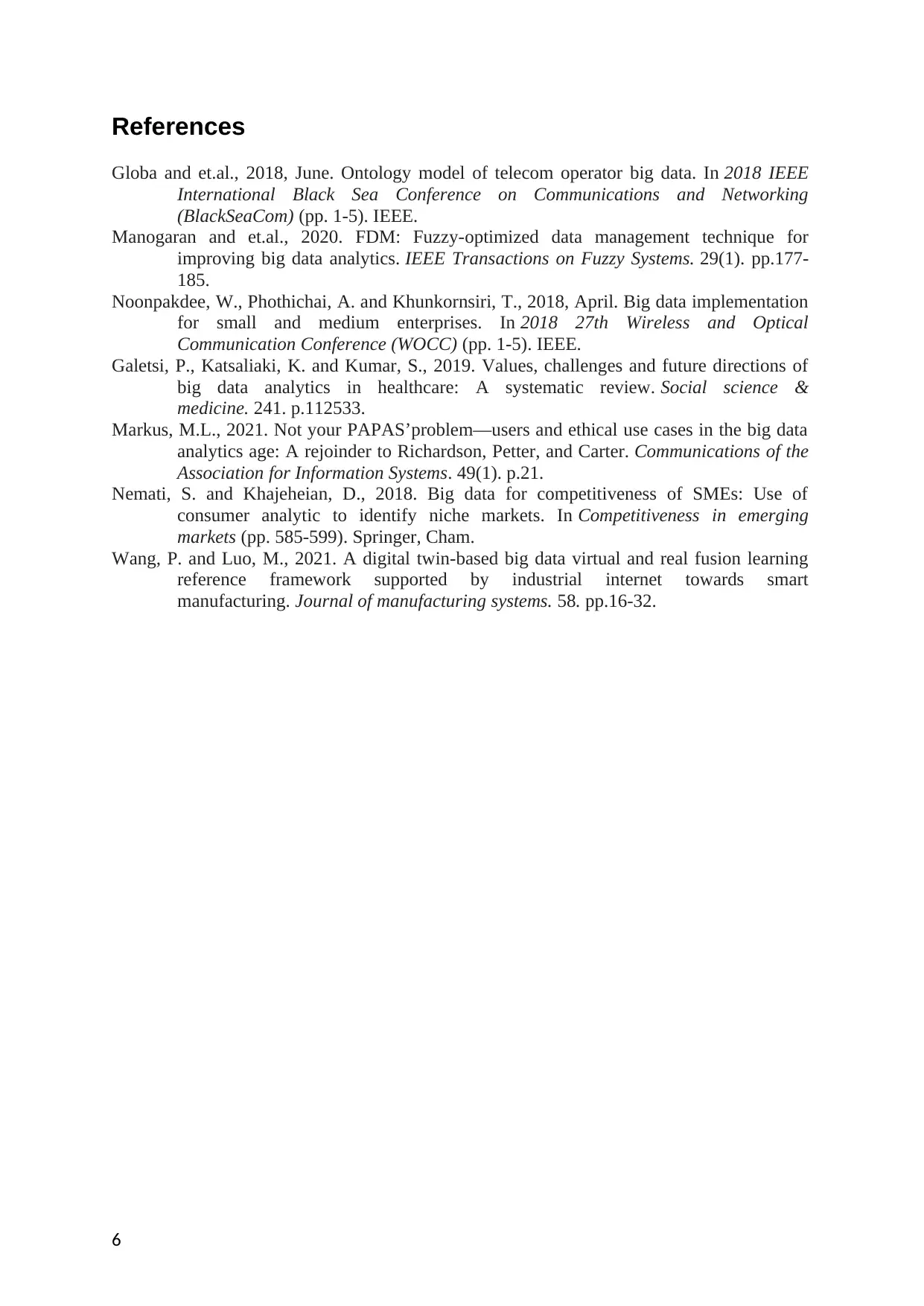
References
Globa and et.al., 2018, June. Ontology model of telecom operator big data. In 2018 IEEE
International Black Sea Conference on Communications and Networking
(BlackSeaCom) (pp. 1-5). IEEE.
Manogaran and et.al., 2020. FDM: Fuzzy-optimized data management technique for
improving big data analytics. IEEE Transactions on Fuzzy Systems. 29(1). pp.177-
185.
Noonpakdee, W., Phothichai, A. and Khunkornsiri, T., 2018, April. Big data implementation
for small and medium enterprises. In 2018 27th Wireless and Optical
Communication Conference (WOCC) (pp. 1-5). IEEE.
Galetsi, P., Katsaliaki, K. and Kumar, S., 2019. Values, challenges and future directions of
big data analytics in healthcare: A systematic review. Social science &
medicine. 241. p.112533.
Markus, M.L., 2021. Not your PAPAS’problem—users and ethical use cases in the big data
analytics age: A rejoinder to Richardson, Petter, and Carter. Communications of the
Association for Information Systems. 49(1). p.21.
Nemati, S. and Khajeheian, D., 2018. Big data for competitiveness of SMEs: Use of
consumer analytic to identify niche markets. In Competitiveness in emerging
markets (pp. 585-599). Springer, Cham.
Wang, P. and Luo, M., 2021. A digital twin-based big data virtual and real fusion learning
reference framework supported by industrial internet towards smart
manufacturing. Journal of manufacturing systems. 58. pp.16-32.
6
Globa and et.al., 2018, June. Ontology model of telecom operator big data. In 2018 IEEE
International Black Sea Conference on Communications and Networking
(BlackSeaCom) (pp. 1-5). IEEE.
Manogaran and et.al., 2020. FDM: Fuzzy-optimized data management technique for
improving big data analytics. IEEE Transactions on Fuzzy Systems. 29(1). pp.177-
185.
Noonpakdee, W., Phothichai, A. and Khunkornsiri, T., 2018, April. Big data implementation
for small and medium enterprises. In 2018 27th Wireless and Optical
Communication Conference (WOCC) (pp. 1-5). IEEE.
Galetsi, P., Katsaliaki, K. and Kumar, S., 2019. Values, challenges and future directions of
big data analytics in healthcare: A systematic review. Social science &
medicine. 241. p.112533.
Markus, M.L., 2021. Not your PAPAS’problem—users and ethical use cases in the big data
analytics age: A rejoinder to Richardson, Petter, and Carter. Communications of the
Association for Information Systems. 49(1). p.21.
Nemati, S. and Khajeheian, D., 2018. Big data for competitiveness of SMEs: Use of
consumer analytic to identify niche markets. In Competitiveness in emerging
markets (pp. 585-599). Springer, Cham.
Wang, P. and Luo, M., 2021. A digital twin-based big data virtual and real fusion learning
reference framework supported by industrial internet towards smart
manufacturing. Journal of manufacturing systems. 58. pp.16-32.
6
⊘ This is a preview!⊘
Do you want full access?
Subscribe today to unlock all pages.

Trusted by 1+ million students worldwide
1 out of 6
Related Documents
Your All-in-One AI-Powered Toolkit for Academic Success.
+13062052269
info@desklib.com
Available 24*7 on WhatsApp / Email
![[object Object]](/_next/static/media/star-bottom.7253800d.svg)
Unlock your academic potential
Copyright © 2020–2025 A2Z Services. All Rights Reserved. Developed and managed by ZUCOL.


